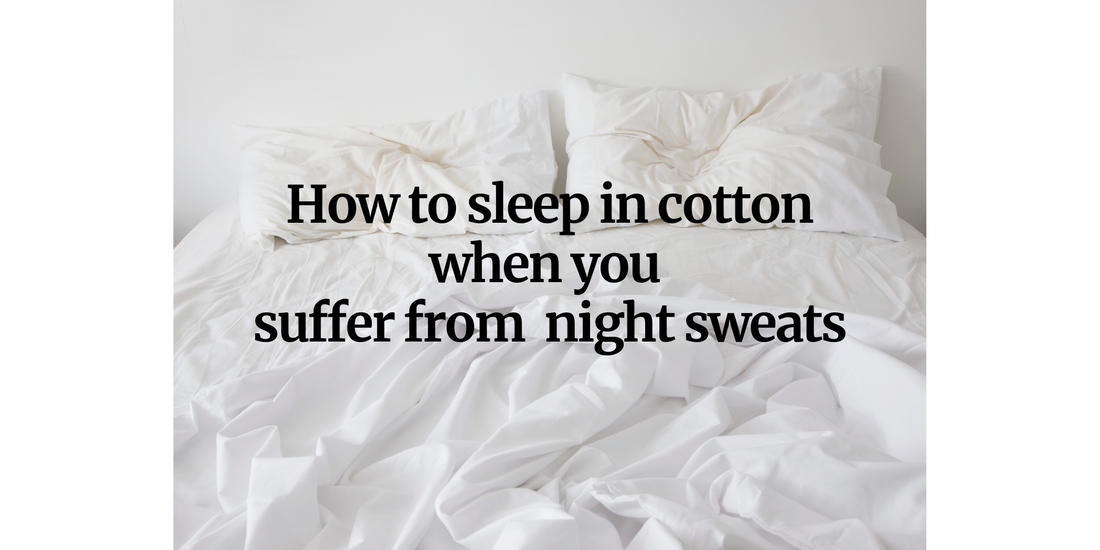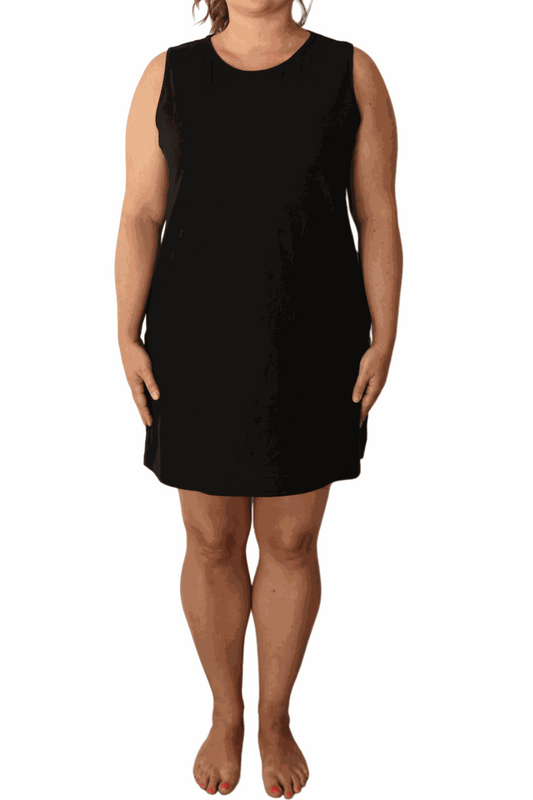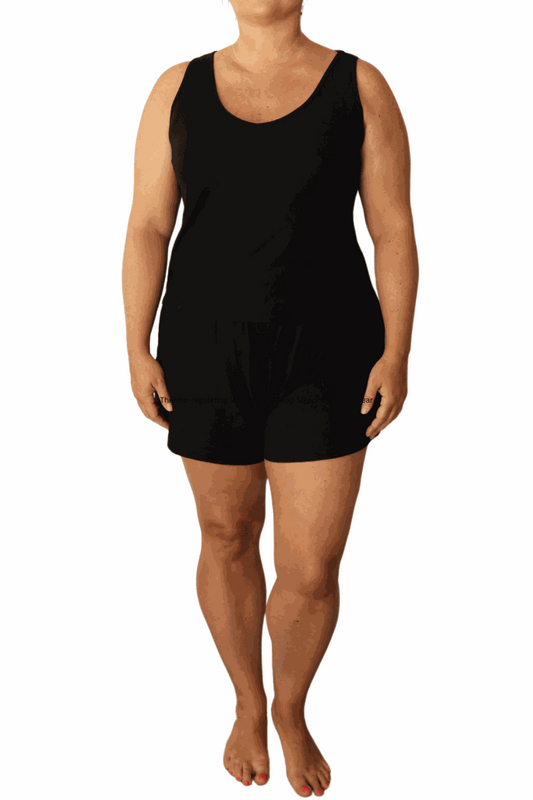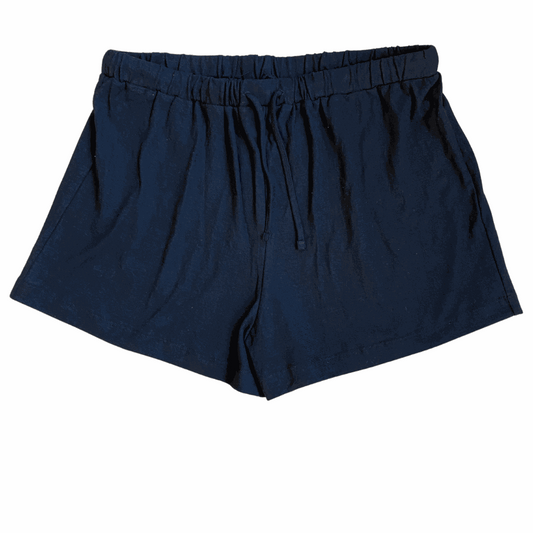
How to Sleep in Cotton When You Have Night Sweats
Share
When we think of trying to find the best possible fabric to sleep in with night sweats, often our thoughts turn to cotton. Cotton is a natural, soft, breathable fabric that’s made into sleepwear, underwear, sheets, blankets, duvet covers and more.
But, as when you have night sweats, sleeping in cotton isn’t as straightforward as I had originally thought.
Night sweats sufferers have a very wonky internal thermostat which causes your body temperature to shoot up while opening up the sweat glands in an effort to cool down your core temperature even though you felt perfectly comfortable before the flush. The flush is followed by your body’s temperature plummeting below normal so that you inevitably feel chilled. It’s this constant temperature swing from hot to cold in addition to the sweat that makes night sweats so miserable.
If night sweats happen frequently during the night you wake up feeling exhausted because you aren’t able to get enough of the deep sleep and REM sleep – two essential sleep phases - you need in order to feel restored in the morning.
(Note: this is a video I made that shows what happens with your temperature during night sweats and how our sleepwear can help flatten the peaks and valleys of them.)
Now, add in soggy, clammy sleepwear and bed linens from all the sweating and sleeping becomes the equivalent of lying in an uncomfortable swamp all night long. It’s awful.
The moisture and drastic temperature change interact with the fabrics you are sleeping in - sleepwear and bedding alike - and one of the most common fabrics is cotton.
Absorbency an often overlooked property that cotton has that plays a key role in your comfort. Cotton absolutely LOVES water. That’s why it’s used for towels.
That’s also why the outdoor community has an expression, “cotton is rotten.”
If you’re an outdoor enthusiast, you avoid cotton in your first or second layer because of just how well cotton clings to water. It does not like to let go of that water molecule so your clothes stay wet for longer leading to that chilled and soggy feeling.

When you sweat in 100% cotton sleepwear, your sleepwear will stay wet for much longer than is comfortable. AND, if you have frequent night sweats, it will not dry between night sweats.
Cotton sleepwear is created for different purposes, most of which don't suit night sweats sufferers
There are many different kinds of cotton sleepwear out there – unfortunately much of it will cause discomfort for night sweats sufferers. Avoid the following types of cotton sleepwear for better comfort:
- Cotton flannel (which is designed to trap heat)
- Heavy cotton jersey (your favourite thick cotton t-shirt)
- Cotton fleece (also designed to trap heat)
- Oxford cloth night shirts
- Cotton/poly blends (the exception to this is specialty blends designed specifically for night sweats)
What about 100% cotton sheets for night sweats?
Some cotton sheets might work for your night sweats, but others will work against you, keeping the moisture next to you so you stay soggy. We’ll explore the different options below.
For a night sweats sufferer, the key to a successful cotton sheet is the weave type and the thread count.
There are two common weave types:
Sateen and Percale.
Sateen sheets are woven in a way that gives them a sheen and a soft drape. But the weave is tighter than percale and traps heat and moisture next to you.
Percale sheets are woven more loosely allowing better breathability while heat can transfer to the other side more easily.
Thread count
This is another factor that may come as a surprise. Sheets with a high thread count (400+) are often called “luxury cotton” sheets. They are very soft with a beautiful drape to them. However, the higher the thread count, the tighter the weave meaning that the sheets will absorb the water and will be slow to let it go while trapping heat next to you.
Does this mean night sweats sufferers should avoid sleeping in cotton?
While I’m not saying you should avoid sleeping in cotton sleepwear and sheets altogether, we need to use cotton strategically in order to take advantage of its amazing absorption properties.
Cotton In sleepwear:
Cotton is an amazing “supporting” fibre. In other words, used as a secondary fibre it promotes faster wicking away from your skin, as long as the primary fibre can do the rest of the work.
For example, our CoolYourSweats sleepwear is a 55%/45% hemp/organic cotton blend. The blend of the hemp and cotton together promotes faster wicking and drying than either hemp or cotton on its own, while the medium-weight allows for excellent heat management so you stay comfortable.
Other examples of effective blends for sleepwear are:
• linen/cotton (55%/45% linen/cotton) and,
• Tencel/cotton (55%/45%).
If you want to use 100% cotton sleepwear, look for the lightest cotton you can find. Sleepwear made from a light muslin weave will dry reasonably fast, as will sleepwear made from mercerized cotton.
One caveat is that because the fabric is so thin and fine, it will not manage heat so you need to rely on your bedding for effective heat management.
Avoid poly/cotton blends (unless specialty sleepwear for temperature regulation) as polyester traps heat and moisture.
What about bamboo/cotton?
Bamboo/cotton blend will perform the exact same way as 100% cotton and will depend entirely on the thickness and weave of the fabric.
Unless there is a specific coating or a special weave that promotes wicking, you will likely not notice a difference between a bamboo/cotton blend and 100% cotton.
Read: "Beyond Bamboo: Alternatives to Bamboo Fabrics for Night Sweats Sufferers"
What to look for in cotton sheets
Cotton sheets are probably the most common form of sheets available as well as having a wide range of quality and price. If you love sleeping in cotton sheets, here’s what to look for when you have night sweats:
• Percale weave,
• 200-350 thread count
• “Pima”, “Supima”, ELS, or Egyptian cotton sheets (Optional feature but it ensures a higher quality sheet that will last longer and won’t pill)
• Organic cotton -GOTS or Oekotex - certified, even better (Optional)
The lighter the cotton sheet, the faster it will dry.
Where 100% cotton shines:
There is a role for cotton in your bed linens – as your thermal layer (blankets, comforter, quilt…).
Because cotton loves water, it will absorb the water in the layer that’s right next to it. So, if you have light cotton sheets and a cotton blanket as your thermal layer, the blanket will draw any water that’s in the sheets. Lighter sheets promote faster drying and a more effective draw to the thermal layer.
Once the moisture is in the last outer layer (your blanket(s), it is free to evaporate.
Excellent thermal cotton layers would be:
1 or 2 cotton blankets, depending on your need for heat
A cotton quilt (including the batting – polyester batting will trap heat and promote sweating)
For the bottom layer, a cotton, non-waterproof mattress cover will work – although it will depend on if your mattress has a top breathable layer. If your mattress is solid foam, including memory foam, this option may not be effective enough to draw the moisture away.
Final Takeaways:
While 100% cotton is not the best choice for sleepwear and bed linens for night sweats sufferers due to its high absorbency, don’t rule cotton out altogether.
Used as a supporting fibre it can help pull moisture away from your body quickly so you stay more comfortable. Further, when layered for optimal absorption from sleepwear through to your mattress cover and thermal layer, cotton can help you stay dry all night long.
DO:
- Use cotton as a supporting fibre (45% is ideal) in blends for sleepwear and bedding, especially when mixed with hemp, linen or Tencel.
DON’T:
- Use 100% cotton fabrics that trap heat and moisture next to you (fleece, flannel, luxury cotton)
- Use cotton/poly blends unless specifically designed to manage temperature changes and moisture.
If you have any questions or comments, please feel free to leave them below.




